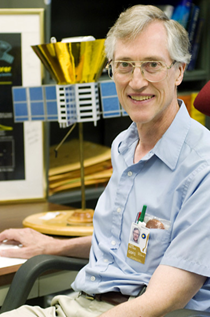- 1610: Galileo
- 1676: Ole Rømer
- 1687: Isaac Newton
- 1781: William Herschel
- 1838: Friedrich Bessel
- 1861: William and Margaret Huggins
- 1912: Henrietta Leavitt
- 1917 Einstein
- 1920: Harlow Shapley
- 1929 Edwin Hubble
- 1948: Ralph Alpher
- 1949: Fred Hoyle
- 1963: Maarten Schmidt
- 1964: Arno Penzias and Robert Wilson
- 1978: Vera Rubin and Kent Ford
- 1989: Margaret Geller and John Huchra
- 1992: John Mather and George Smoot
- 1995: Robert Williams
- 1998: Saul Perlmutter and Brian Schmidt
- 2010: Wendy Freedman
1992: John Mather and George Smoot Image the Infant Universe
 |
| Image of John Mather. Courtesy of John Mather. |
On April 23, 1992, cosmology again made headlines. But this time it was not a bigger picture of galaxies, or a more distant quasar. It was a remarkable image of the universe as an “infant,” only 389,000 years old, when the first atoms were formed and light could finally run free. The slight differences in temperature of the early universe imaged by the COBE satellite gave rise to the formation of stars and galaxies that we see today.
The COBE results also paved the way for the WMAP satellite, with even more sensitive instruments that produced an even sharper image of the early universe and determined its age to be 13.7 billion years. John Mather, at NASA Goddard Institute for Space Studies, and George Smoot at the Lawrence Berkeley National Laboratory later received a Nobel Prize for their work on COBE.
In 1964 Arno Penzias and Robert Wilson announced their finding of a faint microwave signal from all directions that was most likely the afterglow of the Big Bang. The average temperature of the universe appeared to be about 3° Kelvin above absolute zero. Their discovery raised two important questions. First, was the signal really the afterglow of the Big Bang, or did it come from some other source? And second, if the temperature was exactly the same everywhere, how did stars and galaxies form from such a smooth, homogenous mixture of atoms and light? The COBE satellite answered “Yes” to the first question, and confirmed that the microwaves were the afterglow of the Big Bang.
The finding that made front-page news answered the second question. Onboard the satellite was an instrument that measured the intensity of microwaves coming from all directions with great precision. The result would indicate if there were any slight differences in temperature. Prior observations indicated that the background radiation was perfectly smooth, with differences no more than one part in 10,000.
Launching a satellite to measure the microwave background even more precisely would be a very expensive gamble, since the results could be the same as before—no differences in temperature at all. But COBE succeeded in finding very slight differences in temperature from different directions only about one part in 100,000. The differences were small, but big enough to result in the stars and galaxies we see today. In a sense, it was the first “baby picture” of our universe soon after the Big Bang.